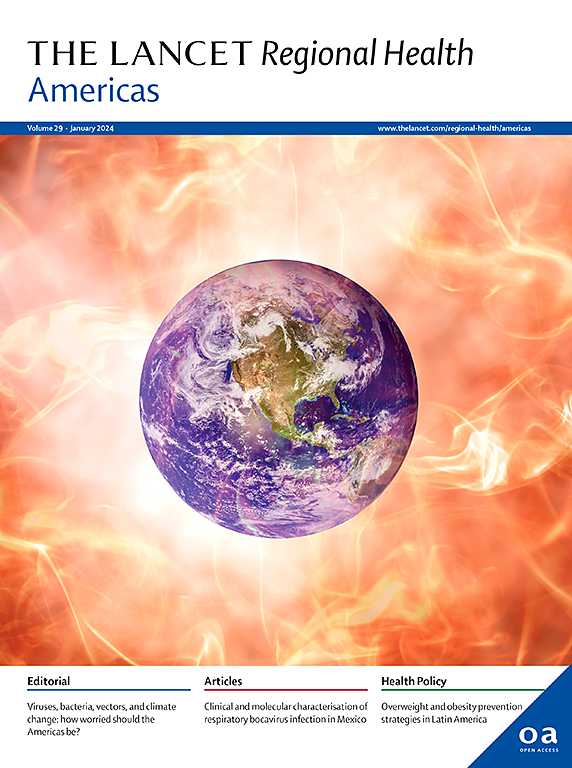2023年10月至2024年3月,美国第一个呼吸道合胞病毒流行季节的婴儿使用nirseimab的有效性:一项阴性设计分析
IF 7
Q1 HEALTH CARE SCIENCES & SERVICES
引用次数: 0
摘要
2023年8月,美国疾病控制与预防中心推荐所有8个月大的婴儿在第一个呼吸道合胞病毒(RSV)季节进入或出生时使用nirsevimab,这是一种长效单克隆抗体。我们的目的是评估2023-2024年RSV流行季期间美国婴儿抗RSV相关急诊科(ED)就诊和住院的nirseimab有效性。方法:我们使用来自6个医疗保健系统的电子健康记录(EHR)数据,包括2023年10月8日至2024年3月31日期间诊断为rsv样疾病(RLI)的急诊科就诊和住院情况,对截至2023年10月1日年龄为18个月或在研究期间出生的婴儿进行了检测阴性分析。通过比较RSV阳性和RSV阴性接触中接受Nirsevimab的儿童和未接受Nirsevimab的儿童,调整年龄、种族和民族、性别、日历日和地理区域,并排除母亲在怀孕期间接受RSV疫苗接种的婴儿,来估计Nirsevimab的有效性。在第一个RSV季节发生RLI的5039例婴儿ED中,2045例(41%)为RSV阳性,446例(9%)接受了尼西莫单抗治疗,自给药以来的中位时间为52天(四分位数间距[IQR]: 27-84天)。在1025例在第一个RSV季节因RLI住院的婴儿中,605例(59%)为RSV阳性,95例(9%)接受了尼塞维单抗治疗,自给药后的中位时间为48天(IQR: 24-82天)。尼瑟维单抗对与rsv相关的ED遭遇的有效性为77% (95% CI: 69%-83%),对与rsv相关的住院治疗的有效性为98% (95% CI: 95% - 99%)。解释:nirsevimab可有效预防第一个RSV流行季节的婴儿与RSV相关的ED接触和住院,对住院有最大的保护作用。然而,这些估计反映了从尼西莫单抗给药到RLI开始的短暂间隔。由于尼瑟维单抗是一种被动免疫,其浓度预计会随着时间的推移而下降,因此继续监测有效性以评估剂量增加后的有效性是很重要的。本研究得到美国疾病控制与预防中心的支持(合同75D30121D12779授予Westat, 75D30123C18039授予Kaiser Foundation Hospitals)。本文章由计算机程序翻译,如有差异,请以英文原文为准。
Effectiveness of nirsevimab among infants in their first RSV season in the United States, October 2023–March 2024: a test-negative design analysis
Background
In August 2023, the Centers for Disease Control and Prevention recommended nirsevimab, a long-acting monoclonal antibody, for all U.S. infants aged <8 months entering or born during their first respiratory syncytial virus (RSV) season. Our aim was to estimate nirsevimab effectiveness against RSV-associated emergency department (ED) encounters and hospitalisation among U.S. infants during the 2023–2024 RSV season.
Methods
We conducted a test-negative analysis using electronic health record (EHR) data from 6 healthcare systems, including ED encounters and hospitalizations with a diagnosis of RSV-like illness (RLI) during October 8, 2023–March 31, 2024, among infants aged <8 months as of October 1, 2023, or born during the study period. Nirsevimab effectiveness was estimated by comparing children who received nirsevimab with those who did not among RSV-positive and RSV-negative encounters, adjusting for age, race and ethnicity, sex, calendar day, and geographic region and excluding infants whose mother received RSV vaccination during pregnancy.
Findings
Among 5039 ED encounters with RLI among infants in their first RSV season, 2045 (41%) were RSV-positive and 446 (9%) received nirsevimab, with a median time since dose of 52 days (interquartile range [IQR]: 27–84 days). Among 1025 hospitalizations with RLI among infants in their first RSV season, 605 (59%) were RSV-positive and 95 (9%) received nirsevimab, with a median time since dose of 48 days (IQR: 24–82 days). Nirsevimab effectiveness was 77% (95% CI: 69%–83%) against RSV-associated ED encounters and 98% (95% CI: 95%–99%) against RSV-associated hospitalisation.
Interpretation
Nirsevimab was effective in preventing RSV-associated ED encounters and hospitalisation among infants in their first RSV season, with greatest protection against hospitalisation. However, these estimates reflect a short interval from nirsevimab administration to RLI onset. Since nirsevimab is a passive immunization and concentration is expected to wane over time, it is important to continue monitoring effectiveness to assess effectiveness with increased time since dose.
Funding
This work was supported by the Centers for Disease Control and Prevention (contracts 75D30121D12779 to Westat and 75D30123C18039 to Kaiser Foundation Hospitals).
求助全文
通过发布文献求助,成功后即可免费获取论文全文。
去求助
来源期刊

Lancet Regional Health-Americas
Multiple-
CiteScore
8.00
自引率
0.00%
发文量
0
期刊介绍:
The Lancet Regional Health – Americas, an open-access journal, contributes to The Lancet's global initiative by focusing on health-care quality and access in the Americas. It aims to advance clinical practice and health policy in the region, promoting better health outcomes. The journal publishes high-quality original research advocating change or shedding light on clinical practice and health policy. It welcomes submissions on various regional health topics, including infectious diseases, non-communicable diseases, child and adolescent health, maternal and reproductive health, emergency care, health policy, and health equity.
 求助内容:
求助内容: 应助结果提醒方式:
应助结果提醒方式:


